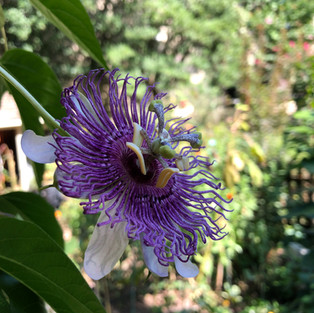Native Plant Gardening: That's Native to the Chesapeake?
- Nuts for Natives
- Jan 27, 2021
- 3 min read
Updated: Jan 27, 2021
Native plants that don't look native.

Last summer, I had both the honor and fun of joining the Washington Gardener, Kathy Jentz, on her podcast Garden DC to talk about native plants. If you don't know Kathy, she is a fountain of knowledge about gardening in the District, Maryland and Virginia!
Kathy asked me a question for which I had absolutely no answer. "Which natives are you surprised to learn are actually native to our area?" Fortunately, Kathy helped me out with some ideas. Since then, I have thought of many others, naturally!
This first is one of the really fascinating things about gardening. Plants can be just amazing. The flowers of maypop vine (Passiflora incarnata) are so stunning, This is the one native to our area. It's a perennial vine that dies back each winter and regrows the following year to about 12 feet. It grows aggressively meaning it will send runners under ground that pop up 10 feet or more from the plant's base. I have found it pretty easy to pull the runners where you don't want them but this year I am going to move the plant into a pot to contain it a bit. So if you plant this, please be forewarned. That said, I just love it. To me, it looks too tropical to be native to the Chesapeake but indeed it is.

If maypop looks like it should be growing in the tropics, this prickly pear cactus looks like it should be in the desert southwest. Yet, eastern prickly pear cactus grows in sandy areas throughout the eastern U.S. The one above is growing at the U.S. Botanical Garden as a low ground cover and actually looks pretty good in the middle of winter. The pinkish red berries above follow yellow flowers in summer. It's reported to be a pollinator magnet and certainly a plus for very dry, sandy areas. I am sure there are some creative garden uses for this, though I am struggling to come up with one at the moment!
Kathy's choice for a plant that is native, but looks like it shouldn't be, is the rose mallow (Hibiscus moscheutos), sometimes called hardy hibiscus. So true. It looks like it should be growing in Florida, the Bahamas or the Caribbean but rose mallow is indeed native. They naturally grow along the edges of marshes. The flower of the straight species is pink or white. These grow best in damp areas in sun. Rose mallow grows to 7 feet high and blooms in July and August. There are many cultivars available as shown above.
A tree that totally seems tropical is the paw paw (Asimona triloba). The tree, growing 15 to 30 feet, bears mango looking fruit and grows wild throughout our area in moister soils. There is a bit to know about growing these and I have just started growing them. Kathy, though, recently talked to "Mr. Paw Paw," Michael Judd, about all you could ever need to know about paw paws here.
I am so glad Kathy asked about native plants that don't look native. She features a number of native plants on her You Tube channel plant profiles. Just go to You Tube and search for "plant profile" and the plant you are interested in or subscribe to Washington Gardener to get them all. I love these because Kathy distills all the information you need to grow a plant into incredibly concise videos.
Here in the Chesapeake watershed, we are lucky to have an incredible array of gardens and experts like the Washington Gardener as well as some exotic looking native plants!



































Comments